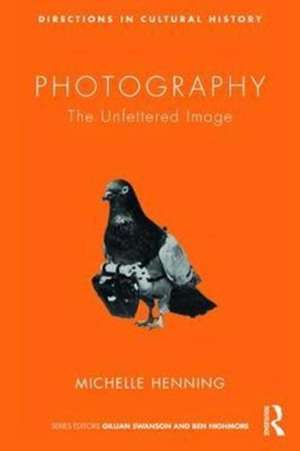Photography: The Unfettered Image: Directions in Cultural History
Autor Michelle Henningen Limba Engleză Paperback – 12 feb 2018
We live in a time in which photographs have become extraordinarily mobile. They can be exchanged and circulated at the swipe of a finger across a screen. The digital photographic image appears and disappears with a mere gesture of the hand.
Yet, this book argues that this mobility of the image was merely accelerated by digital media and telecommunications. Photographs, from the moment of their invention, set images loose by making them portable, reproducible, projectable, reduced in size and multiplied. The fact that we do not associate analogue photography with such mobility has much to do with the limitations of existing histories and theories of photography, which have tended to view photographic mobility as either an incidental characteristic or a fault.
Photography: The Unfettered Image traces the emergence of these ways of understanding photography, but also presents a differently nuanced and materialist history in which photography is understood as part of a larger development of media technologies. It is situated in much broader cultural contexts: caught up in the European colonial ambition to "grasp the world" and in the development of a new, artificial "second nature" dependent on the large-scale processing of animal and mineral materials. Focussing primarily on Victorian and 1920s-30s practices and theories, it demonstrates how photography was never simply a technology for fixing a fleeting reality.
| Toate formatele și edițiile | Preț | Express |
|---|---|---|
| Paperback (1) | 189.84 lei 6-8 săpt. | |
| Taylor & Francis – 12 feb 2018 | 189.84 lei 6-8 săpt. | |
| Hardback (1) | 765.01 lei 6-8 săpt. | |
| Taylor & Francis – 13 feb 2018 | 765.01 lei 6-8 săpt. |
Preț: 189.84 lei
Preț vechi: 230.24 lei
-18% Nou
36.33€ • 38.84$ • 30.29£
Carte tipărită la comandă
Livrare economică 18 aprilie-02 mai
Specificații
ISBN-10: 1138782556
Pagini: 218
Dimensiuni: 156 x 234 x 13 mm
Greutate: 0.4 kg
Ediția:1
Editura: Taylor & Francis
Colecția Routledge
Seria Directions in Cultural History
Locul publicării:Oxford, United Kingdom
Public țintă
Postgraduate and UndergraduateCuprins
Recenzii
Estelle Blaschke, Université de Lausanne, France
" ...Michelle Henning's Photography. The Unfettered Image is a successful attempt to give nuance to the assumption that the era of the digital image would have profoundly transformed what the character of photographs: in reality, the history of the mobility of photographs began much earlier and in many guises."
Transbordeur magazine
"an insightful and deeply-researched resource, notable for its astute synthesis of existing photography literatures as well as for the breadth and richness of its historical material… This book has much to offer for students and scholars of photography, whether they come to it with an interest in the history of photography as a communications medium, in the current state of photography theory, or even simply in one of the special topics that she addresses in her many case studies. "
Frances Cullen, Visual Studies Journal review
Notă biografică
Descriere
We live in a time in which photographs have become extraordinarily mobile. They can be exchanged and circulated at the swipe of a finger across a screen. The digital photographic image appears and disappears with a mere gesture of the hand.
Yet, this book argues that this mobility of the image was merely accelerated by digital media and telecommunications. Photographs, from the moment of their invention, set images loose by making them portable, reproducible, projectable, reduced in size and multiplied. The fact that we do not associate analogue photography with such mobility has much to do with the limitations of existing histories and theories of photography, which have tended to view photographic mobility as either an incidental characteristic or a fault.
Photography: The Unfettered Image traces the emergence of these ways of understanding photography, but also presents a differently nuanced and materialist history in which photography is understood as part of a larger development of media technologies. It is situated in much broader cultural contexts: caught up in the European colonial ambition to "grasp the world" and in the development of a new, artificial "second nature" dependent on the large-scale processing of animal and mineral materials. Focussing primarily on Victorian and 1920s-30s practices and theories, it demonstrates how photography was never simply a technology for fixing a fleeting reality.




























